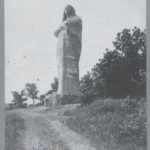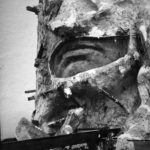About The Statue
 Lorado Taft, who created the 50-foot statue as a tribute to Native Americans, is said to have thought of the figure one evening as he and other members of the Eagles’ Nest colony stood gazing at the view from the bluffs. According to a story attributed to Taft, he and his colleagues tended to stand with their arms folded over their chests. The pose made him think of the Native Americans who were so reverent of the beauty of nature and who probably had enjoyed the same view.
Lorado Taft, who created the 50-foot statue as a tribute to Native Americans, is said to have thought of the figure one evening as he and other members of the Eagles’ Nest colony stood gazing at the view from the bluffs. According to a story attributed to Taft, he and his colleagues tended to stand with their arms folded over their chests. The pose made him think of the Native Americans who were so reverent of the beauty of nature and who probably had enjoyed the same view.
With the help of John G. Prasuhn, a young sculptor of the Chicago Art Institute, Taft created a figure almost 50 feet tall, including a six-foot base. Reinforced with iron rods, the hollow statue is 8 inches to 3 feet thick. The interior is accessible to park employees through a door at the base. The outer surface composed of cement, pink granite chips and screenings, is three inches thick.
The figure is estimated to weigh 100 tons and is thought to be the second-largest concrete monolithic statue in the world. Although Taft dedicated the statue to Native Americans, it has become commonly associated with Black Hawk.
To visit the statue, get more information about Lowden State Park.
History of the Eagles Nest Art Colony
In 1898 Chicago attorney Wallace Heckman, who also was assistant manager of the University of Chicago, purchased the land that was to become Lowden State Park. He and his wife had developed a great love of the outdoors while college students. In Chicago society, the Heckmans also became patrons of the arts. They combined these two interests as an artists’ colony established on their Rock River property. The colony was called “Eagles’ Nest,” referring to a tall, dead cedar tree that clung to the high river bank. The bare, outstretched limbs of the tree inspired Margaret Fuller, a poet of the Concord Group, to write the poem,”Ganymede to His Eagle.”
For nearly 50 years, Eagles’ Nest was a popular home for creative people. The original group included artists Ralph Clarkson, Charles Francis Browne and Oliver Dennet Grove; writers Hamlin Garland, Henry B. Fuller and Horace Spencer Fiske; architects Irving D. and Allen B. Pond; sculptors Lorado Taft and Nellie Walker; organist Clarence Dickinson; and University of Chicago Secretary James Spencer Dickerson. Although Taft was the moving spirit behind the colony, it continued to flourish until 1942, six years after his death.
About a year after the last of the artists and their families left the colony, Gov. Lowden died, and the legislature appropriated $25,000 toward the cost of a memorial to him. The citizens of Oregon and the vicinity, with help from the now Department of Natural Resources, matched that amount so that the former Eagles’ Nest land could be purchased as a memorial park. In 1945, the 63rd General Assembly designated the 273-acre site as Lowden State Park.
Six years later, the 66 acres that composed the actual Eagles Nest Colony were transferred to Northern Illinois University at DeKalb for use as a outdoor teacher education program. The site, called the Lorado Taft Field Campus, was renovated by NIU’s Industrial Arts classes and is used year-round for conducting natural science classes in an outdoor setting.






